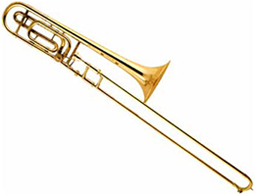Contents:

#1: Trombone
Important info:
Played by: Wind & Lip vibrations
Key: Concert Pitch
Clef: Bass & Tenor
Range:

The trombone is also within the mid range of the brass section and unlike any other brass instrument, it has a slide instead of valves. This has its pros and cons. It’s difficult for trombones to play passages that require playing lots fast notes, for example, a fast run of semiquavers can be very tricky to play because of the hand movements for the different slide positions. The slide makes it easy for glissandi to be played as well as vibrato and bends.
There are seven positions on the trombones slide to produce notes. The first being when the slide is close or closest to the mouth piece and the seventh being when the slide is as far out as it can go.

#2: Slide positions & notes
Glissando
This is when the performer slides from one note to another causing a comical and laughable effect. This effect has become a cliché over the years and so must be used sparingly. The trombone can produce an effective glissando up to an augmented forth, but this is limited by the slide position of both notes. To get a glissando of an augmented forth the first note must be on the first position (if sliding down) or on the seventh position (if sliding up). Back to top